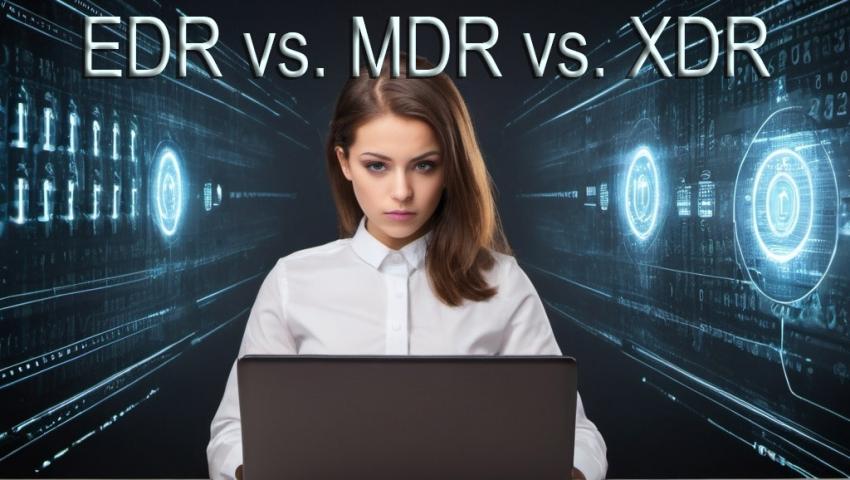
Understanding EDR, EDRR, MDR, and XDR
In the evolving landscape of cybersecurity, protecting digital assets has become increasingly complex. To address this complexity, various solutions like Endpoint Detection and Response (EDR), Managed Detection and Response (MDR), and Extended Detection and Response (XDR) have emerged. Each offers unique capabilities tailored to different security needs. This series will delve into these solutions, starting with an overview and focusing on how Cy-Napea®, a leader in cybersecurity services, implements them.
What is EDR?
Endpoint Detection and Response (EDR) focuses on identifying and responding to threats on endpoints, such as laptops, desktops, and servers. Key features of EDR include:
Continuous Monitoring: EDR tools continuously monitor endpoints for suspicious activity.
Threat Detection: They utilize behavioral analysis and signature-based detection to identify threats.
Response and Remediation: EDR solutions provide automated responses to mitigate threats and tools for manual intervention by security teams.
Forensic Capabilities: They offer detailed logs and analytics to investigate and understand security incidents.
Cy-Napea©'s EDR Service:
Comprehensive Visibility: Cy-Napea®’s EDR solution provides in-depth visibility into endpoint activities.
Real-time Threat Detection: Utilizing advanced machine learning algorithms, Cy-Napea®ensures rapid identification of potential threats.
Automated and Manual Response: The platform supports both automated responses and detailed forensic tools for manual intervention.
What is MDR?
Managed Detection and Response (MDR) takes EDR a step further by integrating human expertise into the detection and response process. Key features include:

24/7 Monitoring: MDR services offer round-the-clock monitoring by cybersecurity experts.
Threat Hunting: Proactive threat hunting is conducted to identify potential threats before they cause damage.
Incident Response: MDR services provide incident response support, often including the expertise of security analysts.
Reporting and Compliance: Regular reports and compliance support are part of the MDR package.
Cy-Napea©'s MDR Service:
Expert Monitoring: Cy-Napea®’s MDR service includes 24/7 monitoring by seasoned cybersecurity professionals.
Proactive Threat Hunting: Leveraging threat intelligence and advanced analytics, Cy-Napea®conducts proactive threat hunting to preempt attacks.
Dedicated Incident Response: The service offers immediate access to incident response experts to handle security breaches effectively.
Comprehensive Reporting: Regular, detailed reports keep businesses informed about their security posture and compliance status.
What is XDR?
Extended Detection and Response (XDR) broadens the scope of EDR by integrating data from multiple security layers, including endpoints, networks, and cloud environments. Key features of XDR include:
Holistic Threat Detection: XDR solutions provide a unified view of threats across various security layers.
Integrated Response: They enable coordinated responses across different security domains.
Advanced Analytics: XDR leverages big data analytics, AI, and machine learning for comprehensive threat detection and response.
Streamlined Security Operations: By consolidating multiple tools and data sources, XDR simplifies security operations and improves efficiency.
Cy-Napea©'s XDR Service:
Unified Security Platform: Cy-Napea®’s XDR solution integrates data from endpoints, networks, and cloud environments into a single platform.
Coordinated Response: The platform facilitates coordinated responses, ensuring swift and effective mitigation of threats.
Advanced Threat Analytics: Utilizing AI and machine learning, Cy-Napea®provides deep insights and predictive analytics to preempt potential threats.
Operational Efficiency: The integrated approach of Cy-Napea®streamlines security operations, reducing complexity and improving overall security posture.
Deep Dive into EDR

Key Components of EDR
EDR solutions are designed to detect, investigate, and respond to threats targeting endpoints. Here are the essential components that make up an EDR system:
Data Collection and Monitoring:
Continuous Monitoring: EDR solutions continuously monitor endpoint activities, capturing data such as process executions, network connections, and file modifications.
Data Storage: Collected data is stored for a certain period, allowing for historical analysis and forensic investigations.
Threat Detection:
Behavioral Analysis: EDR tools analyze behaviors and patterns to detect anomalies that may indicate malicious activities.
Signature-Based Detection: Traditional signature-based detection methods are used to identify known malware and threats.
Machine Learning: Advanced EDR solutions employ machine learning algorithms to detect unknown threats based on behavioral patterns.
Incident Response:
Automated Responses: Automated actions such as isolating an endpoint, killing a malicious process, or blocking a network connection can be triggered upon detection of a threat.
Manual Intervention: Security analysts can manually intervene to conduct deeper investigations and take appropriate actions.
Forensic Capabilities:
Detailed Logs: EDR solutions provide detailed logs and records of endpoint activities, which are crucial for post-incident investigations.
Timeline Analysis: Tools for creating timelines of events help analysts understand the sequence of actions taken by an attacker.
Benefits of EDR
Implementing an EDR solution offers several benefits to organizations:
Enhanced Visibility: EDR provides comprehensive visibility into endpoint activities, making it easier to detect and respond to threats.
Faster Detection and Response: With continuous monitoring and automated responses, EDR solutions enable quicker detection and mitigation of threats.
Reduced Impact of Attacks: Early detection and swift response help minimize the impact of security incidents on business operations.
Improved Forensics: Detailed logs and forensic capabilities aid in understanding attack vectors and preventing future incidents.
Cy-Napea®'s EDR Solution
Cy-Napea®has developed a robust EDR solution that incorporates advanced technologies and methodologies to protect endpoints effectively. Here’s how Cy-Napea®differentiates its EDR service:
Comprehensive Endpoint Visibility:

Cy-Napea®provides real-time visibility into all endpoint activities, ensuring that no suspicious behavior goes unnoticed.
The platform monitors a wide range of endpoint events, including file changes, process executions, network connections, and user behaviors.
Advanced Threat Detection:
Leveraging machine learning and behavioral analysis, Cy-Napea®can identify both known and unknown threats with high accuracy.
The solution includes signature-based detection to catch known malware, combining traditional and modern detection methods for comprehensive protection.
Automated and Manual Response Capabilities:
Cy-Napea®’s EDR solution can automatically respond to detected threats, isolating infected endpoints, terminating malicious processes, and blocking harmful network connections.
Security teams have access to detailed forensic tools for manual investigations, allowing them to conduct thorough analyses and respond appropriately.
Detailed Forensic Analysis:
Cy-Napea®offers extensive forensic capabilities, including detailed logs and timeline analysis, to help security analysts understand the full scope of an incident.
This information is crucial for identifying attack vectors, assessing damage, and preventing future occurrences.
Use Case: Cy-Napea®EDR in Action
Consider a scenario where an organization faces a ransomware attack. Here’s how Cy-Napea®’s EDR solution would respond:
Detection: The EDR system detects unusual file encryption activities and identifies the ransomware based on behavioral analysis and signature matching.
Response: An automated response is triggered, isolating the affected endpoint to prevent the ransomware from spreading to other devices.
Investigation: Security analysts use Cy-Napea®’s forensic tools to investigate the incident, creating a timeline of events to understand how the ransomware entered the system and spread.
Remediation: Based on the investigation, analysts take necessary actions to remove the ransomware, recover encrypted files from backups, and patch vulnerabilities to prevent future attacks.
Deep Dive into MDR
Key Components of MDR

Managed Detection and Response (MDR) combines advanced technology with human expertise to provide robust threat detection and response capabilities. Here are the essential components of an MDR service:
24/7 Monitoring and Detection:
Continuous Surveillance: MDR services provide round-the-clock monitoring of IT environments, ensuring that potential threats are detected at any time.
Advanced Analytics: They utilize advanced analytics and threat intelligence to identify and prioritize potential threats.
Proactive Threat Hunting:
Expert Analysis: Security experts actively hunt for threats, leveraging their expertise and threat intelligence to identify malicious activities that automated systems might miss.
Behavioral Analysis: Analysts use behavioral analysis to detect subtle signs of compromise that indicate advanced persistent threats (APTs).
Incident Response and Remediation:
Immediate Response: Upon detecting a threat, MDR services provide immediate response actions to contain and mitigate the threat.
Expert Remediation: Security experts guide organizations through the remediation process, ensuring thorough resolution and recovery.
Comprehensive Reporting and Compliance:
Detailed Reports: MDR services offer detailed reports on security incidents, including root cause analysis and recommendations for improvement.
Compliance Support: They help organizations meet regulatory and compliance requirements by providing necessary documentation and support.
Benefits of MDR
Adopting an MDR service offers numerous benefits, particularly for organizations with limited internal security resources:
Enhanced Security Posture: MDR provides advanced threat detection and response capabilities, significantly improving an organization’s security posture.
Access to Expertise: Organizations gain access to a team of cybersecurity experts who bring specialized knowledge and experience.
24/7 Protection: Continuous monitoring and threat hunting ensure that threats are detected and addressed promptly, regardless of the time.
Cost-Effective: MDR services can be more cost-effective than building and maintaining an in-house security operations center (SOC).
Cy-Napea®'s MDR Solution
Cy-Napea®offers a comprehensive MDR service that integrates cutting-edge technology with human expertise to provide superior threat detection and response. Here’s how Cy-Napea®distinguishes its MDR service:
Round-the-Clock Monitoring:
24/7 Surveillance: Cy-Napea®’s MDR service provides continuous monitoring of IT environments, ensuring that potential threats are identified and addressed promptly.

Real-Time Alerts: The service delivers real-time alerts and notifications, enabling swift action to mitigate threats.
Proactive Threat Hunting:
Expert Analysts: Cy-Napea®employs a team of seasoned security analysts who actively hunt for threats, utilizing advanced tools and threat intelligence.
Behavioral and Anomaly Detection: The analysts use behavioral analysis and anomaly detection techniques to identify potential threats that may bypass automated systems.
Rapid Incident Response:
Immediate Containment: Upon detecting a threat, Cy-Napea®provides immediate containment measures to prevent further damage.
Guided Remediation: Security experts guide clients through the remediation process, ensuring thorough resolution and minimizing downtime.
Detailed Reporting and Compliance Support:
Comprehensive Reports: Cy-Napea®delivers detailed reports on security incidents, including root cause analysis, impact assessment, and recommendations for improvement.
Regulatory Compliance: The service helps organizations comply with regulatory requirements by providing necessary documentation and support.
Use Case: Cy-Napea®MDR in Action
Consider a scenario where an organization experiences a sophisticated phishing attack. Here’s how Cy-Napea®’s MDR service would handle the situation:
Detection: The MDR system detects unusual login attempts and data access patterns, flagging them as potential indicators of a phishing attack.
Immediate Response: Cy-Napea®’s security analysts initiate an immediate response, isolating affected accounts and systems to prevent further compromise.
Investigation: The analysts conduct a thorough investigation to identify the phishing source, the extent of the compromise, and any affected data.
Remediation: Based on the investigation, Cy-Napea®guides the organization through the remediation process, including resetting credentials, removing malicious emails, and implementing additional security measures.
Reporting and Prevention: Detailed reports are provided to the organization, outlining the incident, response actions, and recommendations to prevent future attacks. Cy-Napea®also helps update security policies and conduct employee training to enhance phishing awareness.
Deep Dive into XDR
Key Components of XDR
Extended Detection and Response (XDR) is designed to provide a holistic view of an organization's security posture by integrating data from various sources, including endpoints, networks, and cloud environments. The essential components of an XDR solution include:

- Integrated Data Sources:
Endpoints: Collects and analyzes data from endpoint devices such as laptops, desktops, and servers.
Network: Monitors network traffic and activities to detect anomalies and potential threats.
Cloud: Integrates cloud security data, providing visibility into cloud workloads and services.
Unified Threat Detection and Response:
Correlation and Analysis: XDR correlates data from multiple sources, using advanced analytics and machine learning to identify complex threats that might evade single-layer detection.
Automated and Orchestrated Response: Provides automated responses and orchestrates actions across different security layers, ensuring a coordinated and efficient threat mitigation process.
Centralized Management and Visibility:
Unified Dashboard: Offers a centralized dashboard for monitoring and managing security events across all integrated data sources.
Comprehensive Visibility: Provides a holistic view of the organization's security posture, enabling better understanding and faster decision-making.
Advanced Analytics and Machine Learning:
Behavioral Analysis: Utilizes behavioral analytics to detect anomalies and suspicious activities.
Threat Intelligence: Incorporates threat intelligence feeds to stay updated on the latest threats and vulnerabilities.
Benefits of XDR
Implementing an XDR solution offers several significant advantages:
Comprehensive Threat Detection: By integrating data from multiple sources, XDR provides a more complete and accurate picture of potential threats.
Coordinated Response: XDR enables a coordinated response across different security layers, ensuring that threats are addressed holistically and efficiently.
Improved Efficiency: Centralized management and automated responses streamline security operations, reducing the burden on security teams and improving overall efficiency.
Enhanced Visibility: A unified dashboard provides comprehensive visibility into the security posture, enabling faster detection and response to threats.
Cy-Napea®'s XDR Solution
Cy-Napea© has developed a state-of-the-art XDR solution that integrates data from endpoints, networks, and cloud environments to provide a unified and comprehensive security platform. Here’s how Cy-Napea®distinguishes its XDR service:
Holistic Security Integration:
Endpoint, Network, and Cloud: Cy-Napea®’s XDR solution collects and analyzes data from endpoints, networks, and cloud environments, ensuring no blind spots in the security landscape.
Data Correlation: The platform correlates data from these diverse sources to detect sophisticated threats that might evade traditional detection methods.
Advanced Threat Detection:

Machine Learning and AI: Cy-Napea®employs advanced machine learning algorithms and AI to analyze data, identify patterns, and detect anomalies that indicate potential threats.
Behavioral Analysis: Behavioral analysis tools help detect unusual activities that deviate from normal behavior, providing early warning of potential threats.
Automated and Orchestrated Response:
Coordinated Actions: Cy-Napea®’s XDR solution enables automated and orchestrated responses across different security layers, ensuring a swift and effective mitigation process.
Customizable Playbooks: The platform supports customizable response playbooks, allowing organizations to tailor automated actions to their specific needs and policies.
Centralized Management:
Unified Dashboard: Cy-Napea®provides a centralized dashboard that offers comprehensive visibility into the organization’s security posture, simplifying monitoring and management tasks.
Real-Time Alerts and Reports: The platform delivers real-time alerts and detailed reports, keeping security teams informed and enabling quick decision-making.
Use Case: Cy-Napea®XDR in Action
Consider a scenario where an organization faces a multi-vector attack involving phishing emails, malware, and unauthorized access attempts. Here’s how Cy-Napea®’s XDR solution would respond:
Detection: The XDR system detects phishing emails through behavioral analysis, malware through endpoint data, and unauthorized access attempts through network traffic monitoring.
Correlation and Analysis: The platform correlates data from these incidents, recognizing them as part of a coordinated attack.
Automated Response: Automated responses are triggered, such as isolating affected endpoints, blocking malicious IP addresses, and alerting security teams.
Orchestrated Actions: The XDR solution orchestrates responses across different security layers, ensuring comprehensive threat mitigation.
Investigation and Reporting: Cy-Napea®’s security analysts conduct a thorough investigation, providing detailed reports and recommendations to prevent future attacks.
What is EDRR?
Extended Detection, Response, and Remediation (EDRR) is an advanced cybersecurity solution that extends beyond threat detection and response by automating and managing the remediation process. With EDRR, threats are not only identified and responded to; the system also takes corrective action, directly addressing the root cause of the threat to prevent recurrence and mitigate damage.
Key Features of EDRR
Automated Remediation:
EDRR solutions go beyond alerting and isolating threats; they implement automated remediation actions, such as removing malicious files, patching vulnerabilities, and restoring affected configurations.
Root Cause Analysis:
EDRR leverages advanced analytics to understand how and why a threat occurred, targeting the root cause rather than only symptoms. This allows for a stronger, proactive security posture by addressing the underlying issues.
Continuous Monitoring and Learning:
EDRR solutions monitor systems continuously and adapt based on observed patterns. Machine learning is often used to predict and prevent similar incidents in the future, enhancing overall resilience.
Centralized Incident Management:
By integrating with broader security infrastructure, EDRR provides a centralized view of incidents across endpoints, networks, and cloud systems, facilitating efficient management of complex security environments.
Advantages of EDRR
Minimized Downtime and Damage:
By automating the remediation process, EDRR reduces the time it takes to restore systems, minimizing disruption and data loss.
Reduced Security Team Workload:
Automated remediation helps alleviate the manual effort required from security teams, allowing them to focus on higher-level tasks and complex threats.
Enhanced Security Posture:
With a proactive approach that includes root cause analysis and continuous improvement, EDRR strengthens an organization’s ability to defend against similar attacks in the future.
Greater Operational Efficiency:
EDRR streamlines threat management by integrating detection, response, and remediation into a single solution, which improves overall efficiency and makes security operations more cohesive.
How Cy-Napea®Implements EDRR
Cy-Napea® has enhanced its security offerings with EDRR capabilities, providing comprehensive threat management. Here are some key features of Cy-Napea® 's EDRR services:
Automated Incident Remediation:
Cy-Napea® automatically identifies and neutralizes threats, applying corrective actions to restore systems to optimal functionality quickly.
Comprehensive Reporting and Insights:
Cy-Napea® offers detailed root cause analysis and reporting for each incident, helping organizations understand threat patterns and improve future defenses.
Seamless Integration Across Environments:
Cy-Napea® ’s EDRR solution integrates with existing security tools, offering centralized incident visibility across on-premises, cloud, and hybrid systems.
Proactive Threat Prevention:
With machine learning capabilities, Cy-Napea® ’s EDRR learns from past incidents to prevent recurrence, adapting its responses to the latest threat landscape.
Is EDRR Right for Your Organization?
EDRR is especially suitable for larger organizations or those with critical infrastructure that require minimal downtime and strong preventative measures. Here’s a quick guide:
Small and Medium Businesses (SMBs): Organizations with limited resources can benefit from the automation of EDRR, but they may need to assess whether the investment is aligned with their specific threat level and needs.
Large Enterprises: EDRR offers an optimal solution for complex environments that require robust incident management, particularly those in critical industries like healthcare, finance, and technology.
Organizations with Limited Security Teams: EDRR's automation and remediation reduce the workload on internal teams, making it ideal for businesses lacking extensive in-house security personnel.
Conclusion
In this series, we have explored the distinct features, benefits, and implementations of EDR, MDR, and XDR. Each solution offers unique capabilities tailored to different security needs, from endpoint protection to integrated, multi-layered security. Cy-Napea®leverages these advanced technologies to deliver comprehensive and effective cybersecurity services, helping organizations safeguard their digital assets against evolving threats.
By understanding the differences between EDR, MDR, and XDR, organizations can make informed decisions about their security strategies, ensuring robust protection in an increasingly complex threat landscape. Cy-Napea®stands out as a leader in providing these cutting-edge solutions, integrating technology and expertise to enhance security and resilience.





